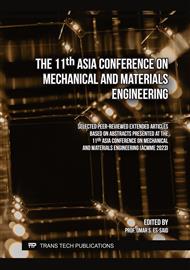p.3
p.11
p.21
p.31
p.39
p.49
p.59
p.65
Development of a Joint Concept for Producing Dissimilar Joints Using a 3D Printing-Supported Technique
Abstract:
The joining of metals and polymer-based materials has a very high interest for many industrial sectors, as it allows to achieve components combining the specific characteristics of each material class. Additive manufacturing technologies could boost the production of these joints, allowing the controlled deposition of a polymeric material over the metal substrate. The present research is aimed to study the feasibility of a joint concept that can be used to produce aluminium/polymer-based material joints through a 3D printing-supported technique. The innovative joint concept, which is based on an interlocking mechanism promoted by a deposited pin, was compared to two conventional concepts. The innovative joint concept allows the production of samples with good mechanical behaviour, in which the failure occurs outside the material overlapping zone. This design is very suitable to be tested for the production of dissimilar material joints.
Info:
Periodical:
Pages:
3-10
Citation:
Online since:
December 2023
Keywords:
Price:
Сopyright:
© 2023 Trans Tech Publications Ltd. All Rights Reserved
Share:
Citation:



